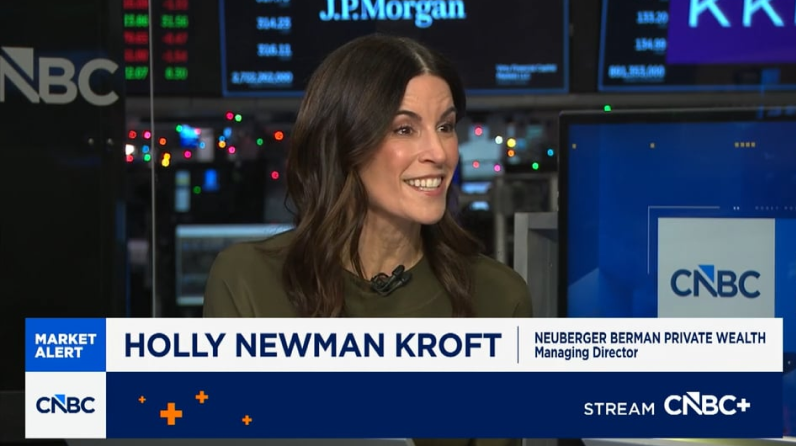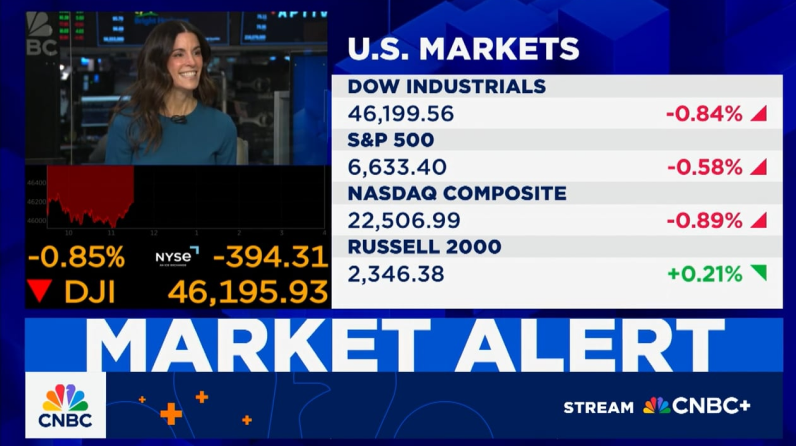

Our outlook remains cautious, and we continue to favor higher-quality areas of the market across asset classes, along with active management to help navigate potential future challenges.
In Short
- Despite concerns around geopolitical events, energy prices moderated and the U.S. economy remained resilient, largely driven by consumer spending and increased inventories
- If 3Q earnings season trends continue, this will be the first quarter of positive S&P 500 Index earnings growth since 3Q 2022
- With the consensus shift to higher-for-longer rates alongside a seemingly robust U.S. economy, longer-term rates have steadily risen even though the Federal Reserve (Fed) has held shorter-term rates steady since July
- Our outlook remains cautious, and we continue to favor higher-quality areas of the market across asset classes, along with active management to help navigate potential future challenges
Looking Back, Looking Forward
October is typically a strong month for equity markets, as discussed in our September Swoon, Oil Boom commentary. However, this year it was marred by the tragic October 7 attack on Israel by the Hamas terrorist group, which sent shockwaves across the globe and immediately pushed commodities (especially oil) higher. Despite concerns around potentially spiraling geopolitical events, U.S. equities were unphased, closing higher on the first post-attack trading day.
Energy prices spiked in 3Q, and renewed conflict in the world’s major oil exporting region later sparked concerns around disruptions to supply, further pushing up prices. Despite these fears, the impact of Mideast tensions on oil so far has been mild, with the price of oil (measured by WTI crude) rising 4% on October 9 (the first post-attack trading day) but ultimately tumbling 6% over the remainder of the month. Any rise in the price of oil can influence expectations for consumer demand and corporate margins, which would then show up in earnings estimates for 4Q and beyond, so we continue to monitor energy prices closely.
As we look ahead, the market reaction to geopolitical events in terms of magnitude and length tends to be closely correlated to the economic backdrop. With comments from the Fed beginning to lean more dovish—signaling that they are “at or near” the end of its rate-hiking cycle—the central bank’s focus, as longer-dated yields move higher, continues to be on inflation measures, the labor market and the consumer, as it seeks insights as to the general health of the U.S. economy.
A Still Resilient U.S. Economy
Continuing its trend of resiliency, the U.S. economy further defied expectations in 3Q with GDP growing quarter-over-quarter at a 4.9% annualized pace—its largest gain since 4Q 2021. The sharp increase was due to contributions from consumer spending and increased inventories. However, we remain cautious: lagged impacts of a higher-for-longer rate environment could trickle down to various areas of the economy, as reflected in the much-lower consensus forecast of 1% GDP growth for 2024.
3Q earnings season is in full swing with 61% of S&P 500 Index companies reporting through the end of October. Company-level insights may be useful to understand the health of the economy from the bottom-up, particularly the impact of a “higher-for-longer” Fed rate alongside sticky-but-cooling inflation and evidence of a modest upswing in manufacturing activity. As of the end of October, the blended earnings growth rate for the S&P 500 Index was 2.9% year-over-year, which, if it holds, would be the first quarter of positive earnings growth since 3Q 2022. Interestingly, the market has generally been “selling the news” on both positive and negative earnings surprises this quarter, suggesting that earnings were largely already baked into prices. There has also been a notable uptick in macroeconomic caution in recent corporate commentary, with 41% of companies thus far cutting forward guidance for the current fiscal year.
S&P 500 Quarterly Earnings Estimates (YoY% Change)

Source: FactSet, As of October 31, 2023. Blended Growth Rate for Q3 2023 is based on existing consensus estimates and reported figures. Q4 2023 Estimate consists of FactSet’s consensus estimates figures for S&P 500 companies.
Fourth-quarter 2023 and fiscal 2024 earnings growth expectations have come down meaningfully as a result, though they remain relatively strong. Since the start of September, 4Q 2023 earnings estimates have declined close to four percentage points to 4.55%, and fiscal 2024 EPS estimates have come down by almost one percentage point to 11.2%, a substantial rebound from projected earnings growth of 0.9% for calendar-year 2023.
With downward pressure on equities remaining pervasive through the second half of 2023 (see the pricing table below), the S&P 500 Index officially closed below its 200-day moving average on October 20 for the first time since March, a key technical indicator that may point to further selling pressure within the asset class. However, oversold conditions, paired with a market-friendly November Federal Open Market Committee meeting allowed equities to bounce back with positive price action through the end of the month. Alongside strong year-to-date returns for the S&P 500 Index (+16.9% through the first half of 2023, -5.4% in the second half through October), we maintain a neutral stance on equities as we continue to navigate potential challenges.
Yields Up, Price Down
Interest rates, ranging from mortgages to auto loans to credit cards, have risen steeply in recent months, with much focus on the 10-year U.S. Treasury yield reaching its highest level since 2007, up a full percentage point in less than three months and briefly surpassing the 5% mark in October.
After the Fed began raising interest rates to fight inflation, the bond market saw a sharp rise in shorter-term yields, including the two-year Treasury, which was tightly correlated to moves in the Fed’s overnight lending rate. However, longer-term yields did not move nearly as much. Throughout its rates campaign, the central bank faced a widely held belief that it would over-tighten, sending the economy into a recession, which would then lead to rate cuts. Now that the consensus narrative has shifted to “higher-for-longer” alongside a seemingly resilient U.S. economy, longer-term rates have steadily risen, even though the Fed has held shorter-term rates steady since July.
U.S. Yield Curve at End of June and October 2023

Bloomberg, As of October 31, 2023.
What changed, and why the spike at the longer end of the curve? Many Fed officials are pointing to the return of the “term premium,” which is worth a brief explanation.
Generally speaking, a bond yield can be broken down into three elements:
- Expectations for the fed funds rate
- The premium for expected inflation
- The term premium
Simply put, the term premium is the added compensation an investor expects for the unknowns associated with holding longer-term debt, while also factoring in long-term expectations for the economy and global financial conditions. Following the global financial crisis, the Fed's efforts to keep borrowing costs low essentially eradicated the term premium because investors believed that the central bank would not raise rates and risk slowing a weaker economy. Thus, there was no expected additional compensation for holding longer-term debt.
A recent uptick in the term premium suggests to us a rise in uncertainty, and we believe there are several reasons for it. As we discussed in August, the large and growing federal budget deficit means that the government may need to borrow more to finance its spending. However, the U.S. Treasury could face difficulty in finding lenders, as some of its largest buyers (both domestic and foreign, including the Fed and China) have cut back. This has increased volatility within the asset class, affecting the price of existing and newly issued Treasuries, which may be giving potential buyers pause. This is already evident in the most recent Treasury auctions, where demand for 30-year Treasury bonds hit its lowest level since December 2021. The U.S. Treasury also recently announced its quarterly refunding, in which it plans to increase its auctions sizes for all maturities, with a focus on shorter-dated bills, where demand has held up better.
The soft demand and likely increased supply, in our view, could continue to push up interest costs for the federal government, which may further widen the U.S. budget deficit. The Congressional Budget Office reported that the deficit for 2023 was roughly $1.7 trillion, a 20% jump from 2022’s $1.4 trillion.
As longer-term yields rise and the cost of credit spreads to various areas of the economy, we continue to favor more defensive positioning and higher-quality areas of the market. For example, high-quality municipal bonds are offering, in our view, attractive yields of over 7% on a tax-equivalent basis.
Portfolio Implications
Equities were broadly negative for the month, with large caps outperforming small caps. We have a market-weight view on equities as part of our overall neutral positioning, moving clients closer to their long-term strategic asset allocations given the ongoing economic uncertainty. Within equities, we still favor lower-beta, higher-quality names, with a neutral view on value versus growth. In this more challenging environment, we also favor looking to active management to select companies with high earnings visibility.
Fixed income was mostly lower, with shorter-dated maturities holding up in a volatile yield environment. Longer-dated yields continued their upward trend. We continue to favor credit markets, maintaining an overweight view on investment grade securities. While cash is still attractive, clients may want to consider a barbell approach within their fixed income allocations given the recent uptick in yields at longer maturities. We maintain a neutral view on high yield to balance risk in portfolios as well as in view of recent spread-tightening that has reduced the asset class’s risk-adjusted return potential. Of note, we recently downgraded emerging markets debt to neutral due to overall global growth fears, particularly in China.
Within private markets, in a challenged fundraising, exit and financing environment, significant opportunities exist for firms and strategies that may act as liquidity and solutions providers to help close the capital supply/demand gap and support value-added transactions. This backdrop, along with Neuberger Berman’s deep relationships and unique position within the private equity ecosystem, has translated into record levels of deal flow across our platform. We continue to see potentially compelling opportunities across secondaries, co-investments, private credit and capital solutions.
Index Returns
| Equities & FX | ||||
|---|---|---|---|---|
| Oct-23 | 1H23 | 2H23 | YTD 2023 | |
| Major U.S. Indices | ||||
| S&P 500 Index | -2.1% | 16.9% | -5.3% | 10.7% |
| Nasdaq Composite | -2.8% | 32.3% | -6.6% | 23.6% |
| Dow Jones | -1.3% | 4.9% | -3.3% | 1.4% |
| U.S. Size Indices | ||||
| Large Cap | -2.4% | 16.7% | -5.5% | 10.3% |
| Mid Cap | -5.0% | 9.0% | -9.4% | -1.3% |
| Small Cap | -6.8% | 8.1% | -11.6% | -4.5% |
| All Cap | -2.7% | 16.2% | -5.8% | 9.4% |
| U.S. Style Indices | ||||
| Large Cap Growth | -1.4% | 29.0% | -4.5% | 23.2% |
| Large Cap Value | -3.5% | 5.1% | -6.6% | -1.8% |
| Small Cap Growth | -7.7% | 13.6% | -14.5% | -2.9% |
| Small Cap Value | -6.0% | 2.5% | -8.7% | -6.5% |
| Global Equity Indices | ||||
| ACWI | -3.0% | 13.9% | -6.3% | 6.7% |
| ACWI ex US | -4.1% | 9.5% | -7.7% | 1.0% |
| DM Non-U.S. Equities | -4.0% | 12.1% | -7.9% | 3.2% |
| EM Equities | -3.9% | 5.1% | -6.6% | -1.8% |
| Portfolios | ||||
| 50/50 Portfolio | -1.5% | 9.8% | -5.0% | 4.2% |
| FX | ||||
| U.S. Dollar | 0.5% | -0.6% | 3.6% | 3.0% |
| Fixed Income & Commodities | ||||
|---|---|---|---|---|
| Oct-23 | 1H23 | 2H23 | YTD 2023 | |
| Major U.S. Indices | ||||
| Cash | 0.4% | 2.3% | 1.8% | 4.1% |
| U.S. Aggregate | -1.6% | 2.1% | -4.8% | -2.8% |
| Munis | -0.9% | 2.7% | -4.8% | -2.2% |
| U.S. Munis | ||||
| Munis Short Duration | 0.1% | 1.0% | -0.8% | 0.2% |
| Munis Intermediate Duration | -0.4% | 1.6% | -3.4% | -1.8% |
| Munis Long Duration | -1.4% | 3.8% | -6.8% | -3.3% |
| U.S. Corporates | ||||
| Investment Grade | -1.9% | 3.2% | -4.9% | -1.9% |
| High Yield | -0.9% | 4.8% | -0.7% | 4.1% |
| Short Duration | 0.3% | 1.1% | 1.1% | 2.2% |
| Long Duration | -4.0% | 4.0% | -12.3% | -8.8% |
| Global Fixed Income Indices | ||||
| Global Aggregate | -1.2% | 1.4% | -4.7% | -3.4% |
| EMD Corporates | -1.3% | 3.3% | -1.7% | 1.5% |
| EMD Sovereigns - USD | -1.4% | 4.1% | -3.6% | 0.4% |
| Commodities | ||||
| Commodities | 0.3% | -7.8% | 5.0% | -3.2% |
| Commodities ex Energy | 1.8% | -2.2% | 0.4% | -1.8% |
| U.S. Treasury Yields | ||||
| U.S. 10-Year Yield | 0.4% | 0.0% | 1.1% | 1.1% |
| U.S. 2-Year Yield | 0.0% | 0.5% | 0.2% | 0.7% |
Source: Bloomberg, total returns as of October 31, 2023. S&P 500 Index is represented by S&P 500 Total Return Index. Nasdaq Composite NASDAQ-Composite Total Return Index. Dow Jones is represented by Dow Jones Industrial Average TR. Large Cap is represented by Russell 1000 Total Return Index. Mid Cap is represented by Russell Midcap Index Total Return. Small Cap is represented by Russell 2000 Total Return Index. All Cap is represented by Russell 3000 Total Return Index. Large Cap Growth is represented by Russell 1000 Growth Total Return. Large Cap Value is represented by Russell 1000 Value Index Total Return. Small Cap Growth is represented by Russell 2000 Growth Total Return. Small Cap Value is represented by Russell 2000 Value Total Return. ACWI is represented by MSCI ACWI Net Total Return USD Index. ACWI ex US is represented by MSCI ACWI ex USA Net Total Return USD Index. DM Non-U.S. Equities is represented by MSCI Daily TR Gross EAFE USD. EM Equities is represented by MSCI Daily TR Gross EM USD. Cash is represented by ICE BofA US 3-Month Treasury Bill Index. U.S. Aggregate is represented by Bloomberg US Agg Total Return Value Unhedged USD. Munis is represented by Bloomberg Municipal Bond Index Total Return Index Value Unhedged USD. Munis Short Duration is represented by Bloomberg Municipal Bond: Muni Short (1-5) Total Return Unhedged USD. Munis Intermediate Duration is represented by Bloomberg Municipal Bond: Muni Intermediate (5-10) TR Unhedged USD. Investment Grade is represented by Bloomberg US Corporate Total Return Value Unhedged USD. High Yield is represented by Bloomberg US High Yield BB/B 2% Issuer Cap Total Return Index Value Unhedged USD. Short Duration is represented by Bloomberg US Agg 1-3 Year Total Return Value Unhedged USD. Long Duration is represented by Bloomberg US Agg 10+ Year Total Return Value Unhedged USD. Global Aggregate is represented by Bloomberg Global-Aggregate Total Return Index Value Unhedged USD. EMD Corporates is represented by J.P. Morgan Corporate EMBI Diversified Composite Index Level. EMD Sovereigns – USD is represented by J.P. Morgan EMBI Global Diversified Composite. Commodities is represented by Bloomberg Commodity Index Total Return. Commodities ex Energy is represented by Bloomberg ExEnergy Subindex Total Return. U.S. 10-Year Yield is represented by US Generic Govt 10 Yr.


VIDEO
The Kantor Group | Charles Kantor’s Year-End Reflections and Key Questions as We Head Into 2026

INSIGHTS
CIO Notebook: Dual Release of Delayed Non-Farm Payrolls Likely Supports Another Cut

INSIGHTS
Using Tax-Free Gifts for Wealth Transfer

INSIGHTS
CIO Notebook: Powell Plays the Middle as Fed Cuts Rates

MARKET COMMENTARY
Giving Thanks for Market Strength

INSIGHTS
CIO Notebook: September U.S. Non-Farm Payrolls Further Complicate the Narrative

VIDEO
Holly Newman Kroft Featured on CNBC’s Money Movers November 18
VIDEO
Plan for Peace of Mind with Our Estate Planning Organizer
MARKET COMMENTARY
Some Tricks, More Treats
INSIGHTS
CIO Notebook: Markets Rattled as Fed Leans Hawkish
REPLAY
Private Wealth Investment Outlook 4Q25
INSIGHTS
CIO Notebook: September Core CPI Comes in Late but Light
INSIGHTS
Charitable Fundraising: Moving Beyond Cash
IMPORTANT INFORMATION:
This material is provided for informational and educational purposes only and nothing herein constitutes investment, legal, accounting or tax advice, or a recommendation to buy, sell or hold a security. This material is general in nature and is not directed to any category of investors and should not be regarded as individualized, a recommendation, investment advice or a suggestion to engage in or refrain from any investment-related course of action. Neither Neuberger Berman nor its employees provide tax or legal advice. All information is current as of the date of this material and is subject to change without notice. The firm, its employees and advisory accounts may hold positions of any companies discussed. Any views or opinions expressed may not reflect those of the firm as a whole. Neuberger Berman products and services may not be available in all jurisdictions or to all client types. Diversification does not guarantee profit or protect against loss in declining markets. Investments in private equity are speculative and involve a higher degree of risk than more traditional investments. Investments in private equity are intended for sophisticated investors only. Unless otherwise indicated, returns shown reflect reinvestment of dividends and distributions. Indexes are unmanaged and are not available for direct investment. Investing entails risks, including possible loss of principal. Past performance is no guarantee of future results.
Portfolio positioning views expressed herein are those of Neuberger Berman’s Investment Strategy Group (ISG), which may include those of the Neuberger Berman’s Asset Allocation Committee. Asset allocation and positioning views are based on a hypothetical reference portfolio. ISG analyzes market and economic indicators to develop asset allocation strategies. ISG works in partnership with the Office of the CIO. ISG also consults regularly with portfolio managers and investment officers across the firm. The Asset Allocation Committee is comprised of professionals across multiple disciplines, including equity and fixed income strategists and portfolio managers. The Asset Allocation Committee reviews and sets long-term asset allocation models, establishes preferred near-term tactical asset class allocations and, upon request, reviews asset allocations for large diversified mandates. Asset Allocation Committee members are polled on asset classes and the positional views are representative of an Asset Allocation
Committee consensus. The views of the Asset Allocation Committee and ISG may not reflect the views of the firm as a whole and Neuberger Berman advisers and portfolio managers may take contrary positions to the views of the Asset Allocation Committee or ISG. The Asset Allocation Committee and ISG views do not constitute a prediction or projection of future events or future market behavior. Defensive positioning generally means an underweight bias on allocations to risk assets such as equities and alternatives. Positioning views may change over time without notice and actual client positioning may vary significantly. Discussion of yield characteristics or total returns of different asset classes are for illustrative purposes only. Such asset classes, such as equities and fixed income, may have significantly different overall risk-return characteristics which should be consider before investing.
The information in this material may contain projections, market outlooks or other forward-looking statements regarding future events, including economic, asset class and market outlooks or expectations, and is only current as of the date indicated. There is no assurance that such events, outlook and expectations will be achieved, and actual results may be significantly different than that shown here. The duration and characteristics of past market/economic cycles and market behavior, including any bull/bear markets, is no indication of the duration and characteristics of any current or future be market/economic cycles or behavior. Information on historical observations about asset or sub-asset classes is not intended to represent or predict future events. Historical trends do not imply, forecast or guarantee future results. Information is based on current views and market conditions, which will fluctuate and may be superseded by subsequent market events or for other reasons.
Discussions of any specific sectors and companies are for informational purposes only. This material is not intended as a formal research report and should not be relied upon as a basis for making an investment decision. The firm, its employees and advisory accounts may hold positions of any companies discussed. Nothing herein constitutes a recommendation to buy, sell or hold a security. It should not be assumed that any investments in securities, companies, sectors or markets identified and described were or will be profitable. Investment decisions and the appropriateness of this content should be made based on an investor's individual objectives and circumstances and in consultation with his or her advisors.
Neuberger Berman Investment Advisers LLC is a registered investment adviser.
The “Neuberger Berman” name and logo are registered service marks of Neuberger Berman Group LLC.